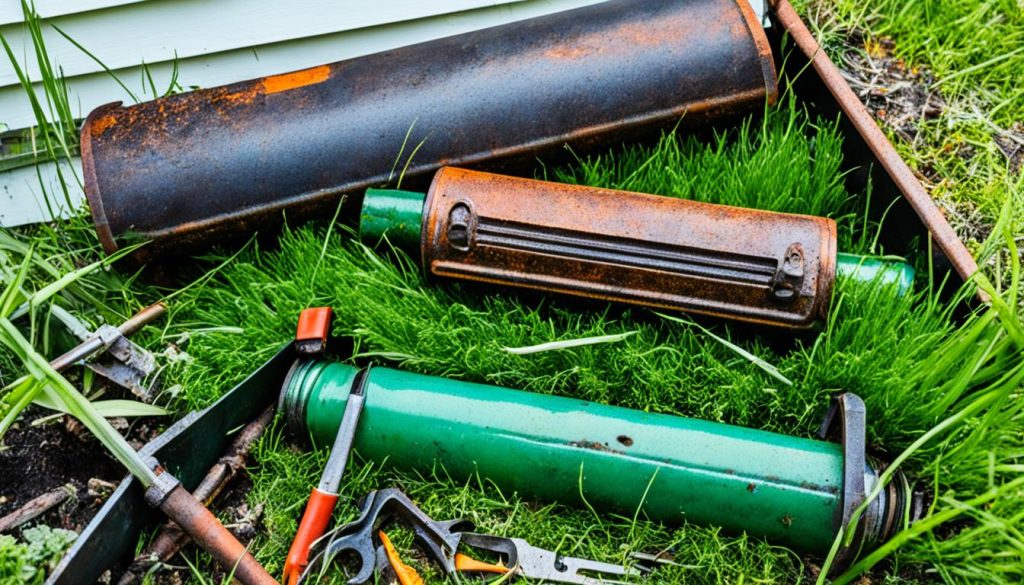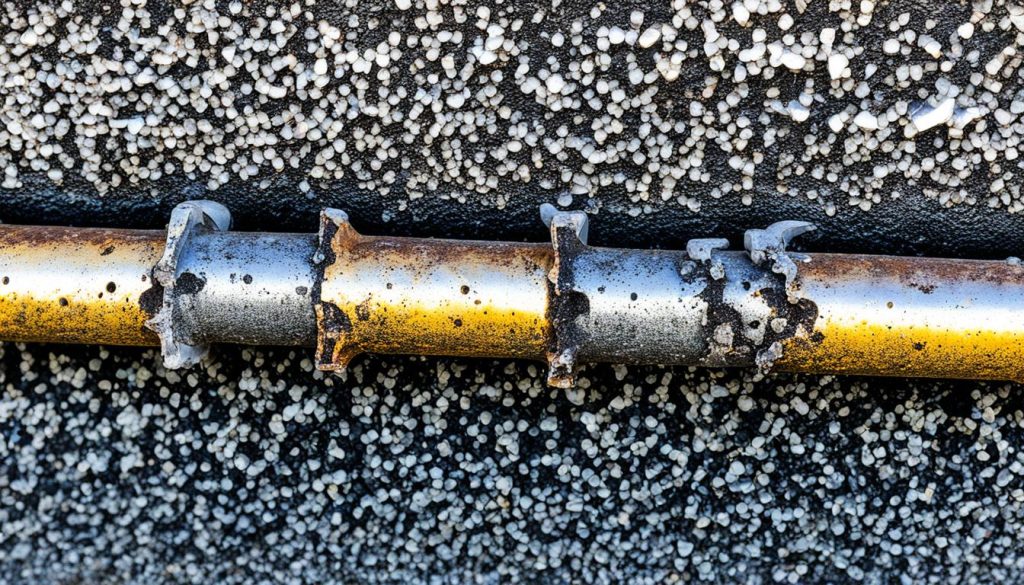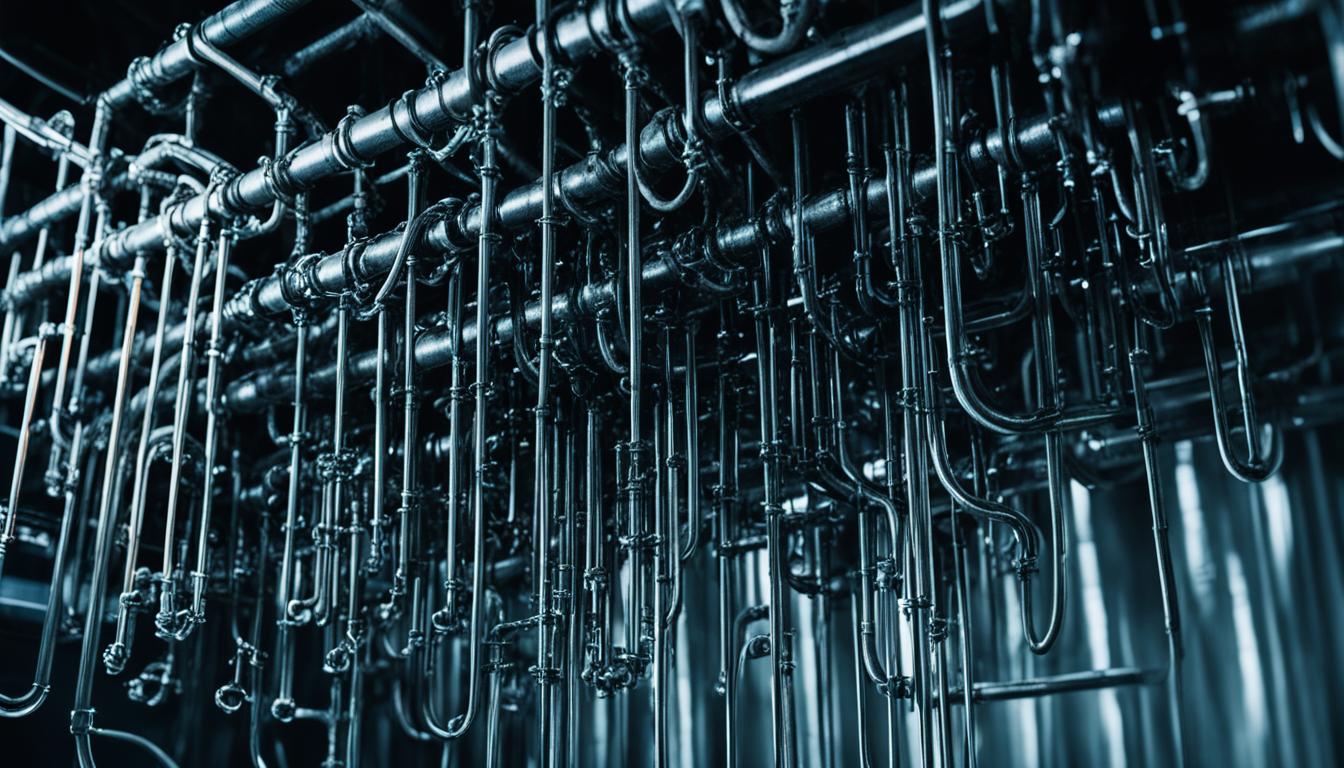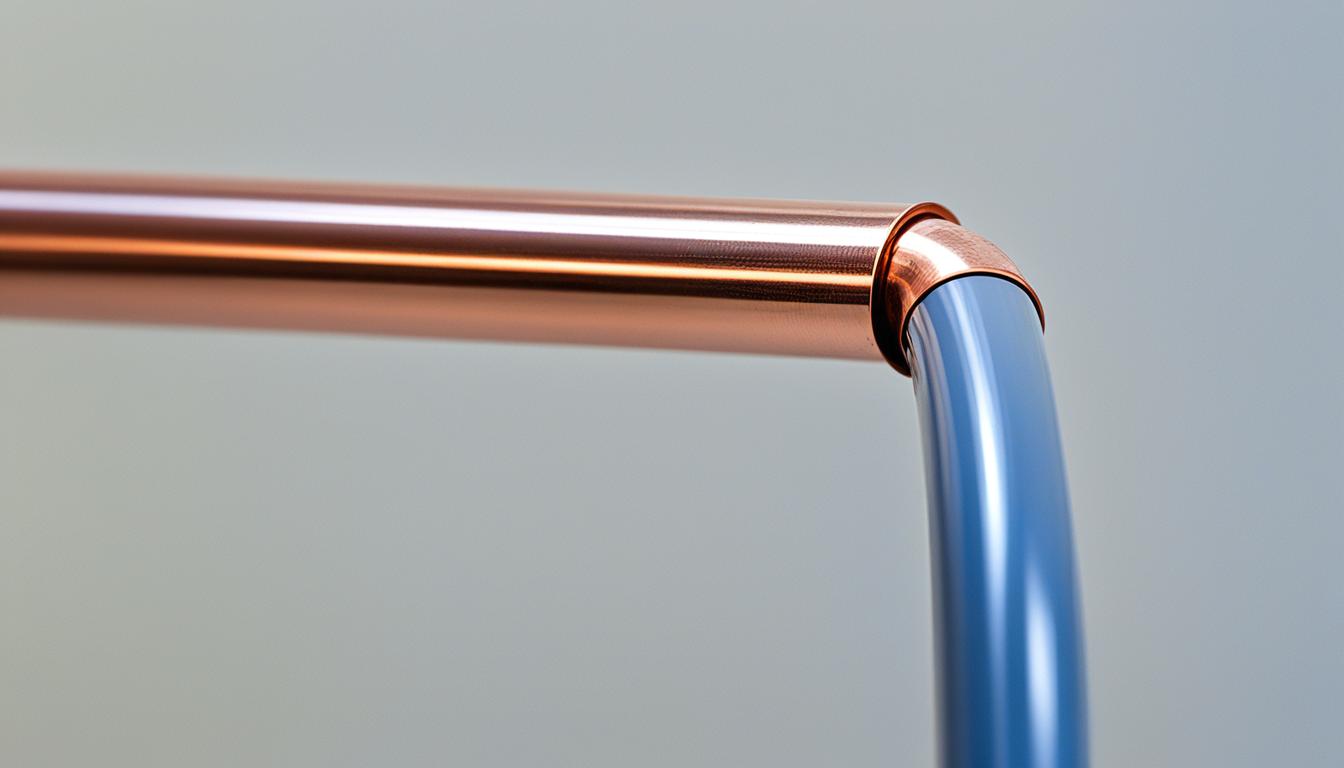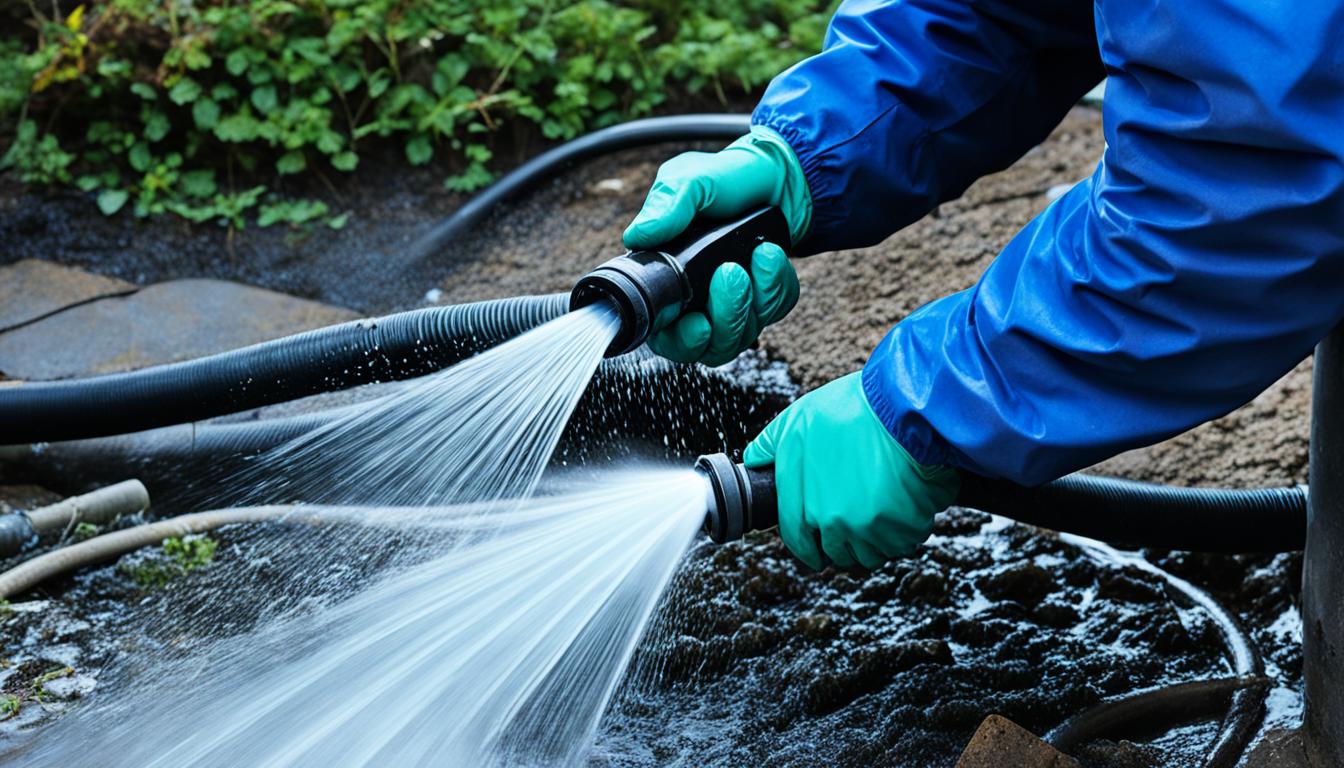Lifespan of Cast Iron Pipes – Learn the Duration!
Did you know that cast iron pipes, commonly found in homes built before 1975, have a lifespan that can range from 50 to 100 years? It’s true! These durable pipes have been relied upon for decades to safely transport sewage and wastewater. However, the longevity of cast iron pipes can be affected by various factors, including deterioration that can occur as early as 25 years.
If you have cast iron pipes in your home, it’s important to be aware of potential signs of trouble. Rust, decay, discoloration, cracks, sporadic leaks, slow drains, clogs, foul smells, water damage, and even pest infestations can all indicate issues with your cast iron pipes. Corrosion, caused by soil acidity and the sewage running through the pipes, is a common problem that can lead to the deterioration of these pipes.
Key Takeaways:
- Cast iron pipes have a lifespan of 50 to 100 years, but deterioration can occur after just 25 years.
- Signs of trouble include rust, decay, discoloration, cracks, sporadic leaks, slow drains, clogs, foul smells, water damage, and pest infestations.
- Corrosion, caused by soil acidity and sewage, is a common issue with cast iron pipes.
- Regular inspections and maintenance can help extend the lifespan of cast iron pipes.
- Proper care and addressing issues promptly are key to maintaining the durability of cast iron pipes.
Reasons for Cast Iron Pipe Deterioration
Deterioration of cast iron pipes can occur due to both external and internal factors. Understanding the signs of cast iron pipe deterioration is crucial for timely repairs and maintenance. Here are the main reasons why cast iron pipes deteriorate:
1. External Corrosion
- High soil acidity can corrode cast iron pipes over time.
- Stray electric currents in the soil can cause galvanic corrosion, leading to pipe deterioration.
- Toxins present in the soil can also contribute to external corrosion of cast iron pipes.
2. Internal Corrosion
- The acidity of sewage running through cast iron pipes can lead to internal corrosion.
- Sewage contains sulfuric acid, which reacts with cast iron and accelerates pipe deterioration.
- Household drain cleaners that contain sulfuric acid can contribute to internal corrosion.
Both external and internal corrosion can result in various signs of cast iron pipe deterioration, such as rust, cracks, discoloration, and leaks. Timely action is necessary to prevent further damage and the need for pipe replacement.
| Signs of Cast Iron Pipe Deterioration | Cause |
|---|---|
| Rust | External or internal corrosion |
| Cracks | External or internal corrosion |
| Discoloration | External or internal corrosion |
| Leaks | External or internal corrosion |
| Sporadic leaks | External or internal corrosion |
| Slow drains | Internal corrosion |
| Clogs | Internal corrosion |
| Foul smells | Internal corrosion |
| Water damage | External or internal corrosion |
| Pest infestations | External or internal corrosion |
Common Issues with Cast Iron Pipes
When it comes to cast iron pipes, homeowners commonly face a range of issues that can impact the functionality and longevity of their plumbing system. It’s essential to address these issues promptly and take measures to extend the life of your cast iron pipes. Here are some common problems to watch out for and maintenance tips to keep your pipes in good condition:
1. Leaks
One of the most common issues with cast iron pipes is the occurrence of leaks. Over time, corrosion and deterioration can cause small cracks or holes to develop in the pipes, leading to water leakage. If left unattended, these leaks can cause water damage and structural issues. Regular inspections and timely repairs can help prevent leaks and ensure the integrity of your plumbing system.
2. Water Discoloration
Rusty cast iron pipes can contribute to water discoloration in your faucets and fixtures. This occurs when the rust flakes off and mixes with the water supply. Not only is discolored water unappealing, but it can also indicate underlying pipe corrosion. If you notice water discoloration, it’s crucial to have your pipes inspected and consider appropriate measures such as relining or replacing them.
3. Poor Water Pressure
Cast iron pipe deterioration can also lead to poor water pressure in your home. Accumulated rust, scaling, or blockages can restrict the flow of water and affect the overall performance of your plumbing system. Regular maintenance, including drain cleaning and pipe flushing, can help remove these obstructions and restore optimal water pressure.
4. Slow Drainage
Over time, cast iron pipes may develop obstructions and buildup, resulting in slow drainage. This can be caused by a variety of factors, including the accumulation of debris, corrosion, or sagging pipes. Snaking or jetting the sewer lines can help clear blockages and restore efficient drainage. Regular maintenance of your plumbing system can help prevent these issues and maintain proper functionality.
5. Ground Sagging and Wastewater Pooling
As cast iron pipes age and deteriorate, the ground surrounding them may start to sag. This can lead to improper slope or alignment, causing wastewater to pool in certain areas. If left unaddressed, this can result in foul odors, water damage, or structural issues. Regular inspections and proactive maintenance can help detect ground sagging early and prevent wastewater pooling.
Extending the Life of Cast Iron Pipes: Maintenance Tips
To ensure the longevity and functionality of your cast iron pipes, here are some maintenance tips to consider:
- Avoid introducing grease, highly acidic or alkaline liquids, and construction waste into your plumbing system. These substances can contribute to corrosion and blockages in the pipes.
- Regularly inspect your pipes for signs of deterioration, such as rust, cracks, or leaks. Promptly address any issues that arise.
- Consider professional pipe relining when necessary to reinforce the structural integrity of your pipes and prevent further deterioration.
- Schedule regular maintenance, including sewer line snaking or jetting, to prevent the buildup of debris and obstructions in your pipes.
- Consult with a professional plumber for expert advice and assistance with maintaining your cast iron pipes.
A proper maintenance routine along with early detection and prompt repairs can significantly extend the life of your cast iron pipes. By taking these proactive measures, you can avoid costly repairs or full-scale pipe replacements in the future.
Factors Affecting the Lifespan of Cast Iron Pipes
The durability of cast iron pipes can be influenced by various factors. Understanding these factors is crucial in ensuring the longevity of your plumbing system. Here are the key factors that can affect the lifespan of cast iron pipes:
- Pipe material: The quality of the cast iron used in the pipes can significantly impact their durability. Pipes made from high-quality cast iron are more resistant to corrosion and have a longer lifespan.
- Weather conditions: Extreme temperatures and weather conditions can affect the structural integrity of cast iron pipes. Freezing temperatures, for example, can lead to cracks and leaks.
- Environmental factors: The composition of the soil and the presence of corrosive substances can impact the lifespan of cast iron pipes. Highly acidic or alkaline soil can accelerate corrosion, reducing the pipes’ longevity.
- Care and maintenance: Proper care and regular maintenance can significantly extend the lifespan of cast iron pipes. Preventative measures, such as regular inspections and cleaning, can help detect and address issues before they escalate.
To illustrate the impact of these factors on the lifespan of cast iron pipes, refer to the table below:
| Factor | Effect on Lifespan |
|---|---|
| Pipe Material | Influences durability and corrosion resistance |
| Weather Conditions | Potential for cracks and leaks in extreme temperatures |
| Environmental Factors | Presence of corrosive substances in the soil |
| Care and Maintenance | Regular inspections and proper cleaning can extend lifespan |
By considering these factors and taking appropriate measures, you can maximize the lifespan of your cast iron pipes and avoid costly repairs or replacements.
Connecting PVC and Cast Iron Pipes
When it comes to connecting worn-out cast iron sewer pipes to PVC pipes, homeowners often face a challenge. The traditional method involves digging up the ground and replacing the cast iron pipes with new PVC pipes. While effective, this approach can be costly, time-consuming, and disruptive to your property.
An alternative and more efficient method is pipe lining. With pipe lining, a new pipe is inserted inside the existing cast iron pipe using a flexible sock soaked in epoxy. This technique not only connects the cast iron and PVC pipes seamlessly but also provides additional strength and durability to the old pipe. The process requires minimal digging and can be completed without causing much disruption to your property.
This innovative pipe lining method is not only more cost-effective but also comes with a lifetime guarantee, giving you peace of mind knowing that your sewer system is well protected. However, it’s crucial to hire a professional plumber with experience in pipe lining to ensure the job is done properly. A professional plumber will have the expertise and knowledge to connect the cast iron and PVC pipes securely, preventing leaks or other potential issues.
By opting for pipe lining instead of traditional pipe replacement, you can save time, money, and avoid unnecessary disruption to your property. The seamless connection between cast iron and PVC pipes ensures a reliable and long-lasting solution for your plumbing needs.
Maintenance and Servicing of Cast Iron Pipes
Ensuring the longevity of cast iron pipes requires regular maintenance and servicing. By taking proper care of your pipes, you can prevent costly repairs and extend their lifespan.
Start by inspecting the pipes for any signs of damage, such as cracks, rust, or leaks. If you notice any issues, it’s important to address them promptly to prevent further deterioration.
In addition, snaking or jetting the sewer lines can help clear any blockages or buildup, ensuring a smooth flow of wastewater. It’s recommended to have your septic tank pumped every three years to prevent any overflow or backups.
To maintain the integrity of your cast iron pipes, avoid introducing foreign objects or substances that can cause damage. This includes disposing of grease properly and avoiding the use of highly acidic or alkaline liquids in your drains.
If you are purchasing a home or experiencing recurring blockages, sewer inspections are highly recommended. A professional plumber can conduct a thorough assessment of your sewer system to identify any potential issues.
By prioritizing maintenance and servicing, you can keep your cast iron pipes in optimal condition and ensure the smooth operation of your sewer system for years to come.
Source Links
- https://www.balkanplumbing.com/life-expectancy-of-cast-iron-sewer-pipe/
- https://www.pipelawsuit.com/blog/houses-built-before-1975/
- https://www.deluxeplumbing.com/knowledge/how-long-does-cast-iron-pipe-last
- Investing Wisely: How Windows & Doors in Boost Property Value and Financial Health - April 24, 2025
- The Financial Impact of Personal Injuries: Why Legal Help Matters for Business Owners - April 16, 2025
- The Hidden Financial Costs of Domestic Assault: What Business Owners Need to Know - April 16, 2025
